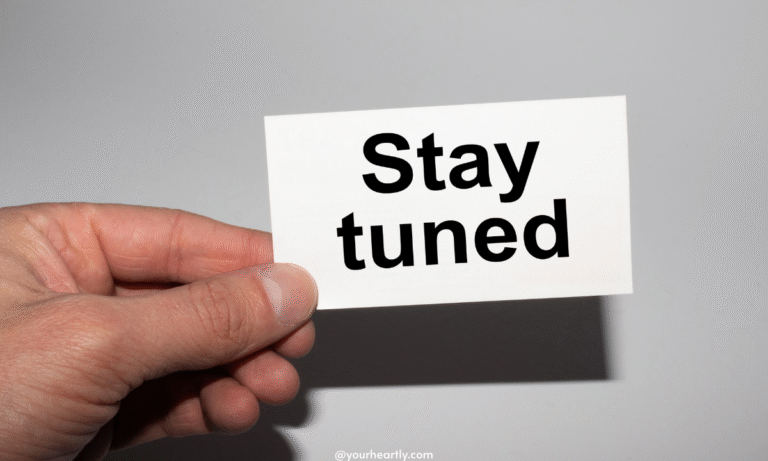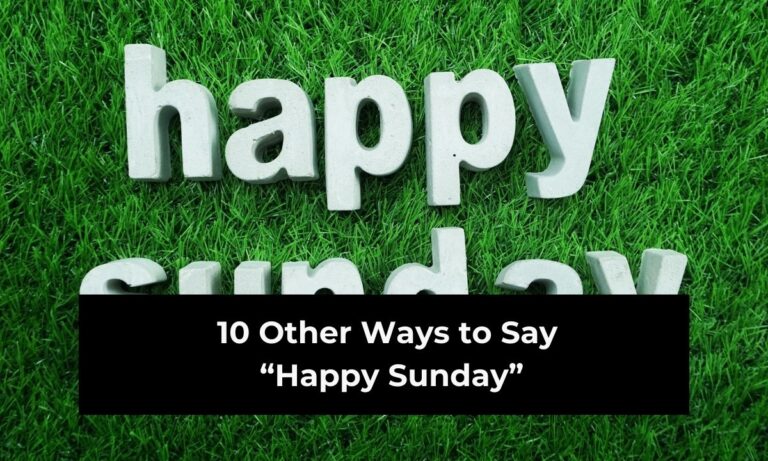Sometimes, ending a conversation can feel a little… mechanical. If you’re always typing or saying “Talk to you then,” you might notice it starts to sound like a script rather than a genuine send-off. And while there’s nothing wrong with the phrase itself, it can lack the spark that keeps your interactions warm, friendly, and personal.
You’ve probably been there: you’re wrapping up a chat with a friend, a colleague, or even a client, and you want to leave a lasting, positive tone. But instead of going for something creative or meaningful, you default to the same old “Talk to you then.” Over time, it can start to feel as bland as plain toast.

Here’s the good news: you have options. In fact, you have plenty of ways to end a conversation that keep it natural, memorable, and perfectly suited to the moment. Whether you’re texting, emailing, or speaking in person, a thoughtful alternative can give your farewell more personality.
In this article, we’re going to explore 12 other ways to say “Talk to you then” — each with its own flavor, tone, and best-use scenario. We’ll cover phrases that are playful, professional, and everything in between. You’ll see how small tweaks can make your communication feel warmer, more authentic, and even more memorable.
Must Read:
- Other Ways to Say “Talk to You Soon”
- Other Ways to Say “Stay Tuned”
- Other Ways to Say “Take Your Time”
By the time you finish reading, you’ll have a toolkit of options that you can pull from whenever you want to end a conversation gracefully — whether you’re chatting with a lifelong friend or wrapping up a work meeting. So, let’s dive into these alternatives that will make your goodbyes stand out for all the right reasons.
1. “Catch You Later”
This casual, upbeat phrase is perfect when you want to keep things light and friendly. “Catch you later” works especially well in informal conversations with friends, peers, or acquaintances you see regularly.
When you use it, you’re suggesting that another conversation is naturally on the horizon. It carries a sense of familiarity, as though you already expect to bump into each other soon — no strict schedule needed. In a text conversation, it can soften the ending and keep it open-ended, while in person, it’s a quick, cheerful way to wrap things up without sounding abrupt.
The tone here is approachable and modern, making it versatile for both social and semi-professional contexts (as long as your workplace leans casual). For example, if you’re messaging a coworker about lunch plans, “Catch you later” is a friendly wrap-up that avoids sounding too formal.
One of the strengths of this phrase is that it doesn’t lock you into a specific time, so you don’t risk overpromising. Instead, it leaves space for the next interaction to happen naturally. That flexibility is part of why it feels so effortless and genuine.
If you want to keep it extra warm, you can pair it with a friendly detail or callback to your conversation. For example: “Catch you later — and don’t forget to bring your lucky pen for the meeting!” This makes it personal and helps the other person feel remembered.
2. “Speak Soon”
“Speak soon” feels warm but slightly more polished than some other casual alternatives. It’s a great choice when you want to end on a friendly note while still sounding considerate and engaged.
The phrase works well in emails, text messages, or verbal exchanges, especially when you do expect to talk in the near future. It subtly communicates that you value the relationship and are already looking forward to the next exchange. That’s why it’s popular among both friends and professional contacts.
In professional settings, “Speak soon” can feel more approachable than “I look forward to hearing from you,” which can come across as stiff. In personal contexts, it can feel like a gentle promise of reconnection.
The beauty of “Speak soon” is its adaptability. You can use it after a quick chat with a coworker, a friend’s check-in, or even in customer communication. It feels personal without being overbearing.
If you want to enhance it, try adding a time frame or hint of anticipation: “Speak soon — can’t wait to hear how your project turns out!” This makes the phrase more vivid and keeps the connection alive.
3. “Talk Later”
Short, sweet, and to the point — “Talk later” is a stripped-down version of the original phrase. It’s an easy choice when you’re in a rush but still want to acknowledge the conversation’s future.
Because of its brevity, “Talk later” works best in casual conversations, particularly with friends or family. In texting, it’s a good alternative to leaving a chat hanging, and it signals that you’re not cutting things off entirely.
While it’s minimalist, it still carries warmth if you say it with the right tone. In person, a smile or upbeat inflection can give it the friendliness it needs. In writing, you can soften it with a friendly add-on, like: “Talk later — I’ll send you that recipe soon.”
The simplicity here is the main benefit. It’s straightforward and doesn’t require extra thought, making it easy to use in fast-paced situations. However, because it’s so concise, it might feel too abrupt in formal contexts. Reserve it for people who already know your communication style.
4. “Let’s Touch Base”
If you’re in a professional or semi-professional environment, “Let’s touch base” can be a more strategic alternative. It’s often used in business settings to suggest following up or checking in on progress.
The phrase implies a purposeful conversation rather than just a casual chat. For instance, you might say it after discussing a project deadline or collaborative task: “Let’s touch base next week once we have the numbers.” This makes it clear there’s a specific reason for reconnecting.
“Let’s touch base” works well in emails, meetings, and phone calls where you want to convey efficiency and focus. It’s also a great way to keep things open-ended while still maintaining a professional tone.
One important thing to note: while it’s common in corporate language, it can sometimes feel overused or cliché in certain industries. To keep it fresh, you can add context or detail: “Let’s touch base Tuesday morning after the client call.” This shows you’re intentional about the timing and purpose.
5. “Chat Soon”
“Chat soon” has a relaxed, modern feel that works in both personal and casual professional exchanges. It’s a gentle promise of reconnecting without tying yourself to a strict timeline.
This phrase works beautifully in friendly emails, text messages, or voice conversations. If you’re wrapping up a brainstorming call with a colleague, “Chat soon” keeps things light but still signals continuity.
The casual tone makes it approachable for all ages and situations. You could send it to a long-distance friend or a fellow volunteer at a local event. It’s friendly but not overfamiliar, so it won’t catch anyone off guard.
For extra warmth, you could say: “Chat soon — I want to hear all about your weekend trip!” Adding a personal touch keeps the conversation alive and invites the other person to engage when you reconnect.
6. “Until Next Time”
This phrase has a certain elegance to it, making it feel timeless and thoughtful. “Until next time” suggests that your conversation is part of an ongoing connection, and there’s a shared understanding that you’ll meet or talk again.
It works beautifully in both formal and informal contexts. In personal settings, it can feel poetic or nostalgic. In professional settings, it can serve as a polished, graceful sign-off that still feels warm.
The charm of “Until next time” lies in its ability to be both hopeful and certain. You’re not scheduling the next interaction, but you’re expressing confidence it will happen.
If you want to give it more personality, you could tailor it: “Until next time — I’ll keep an eye out for your update!” This keeps the sentiment alive and grounded in the context of your discussion.
7. “Looking Forward to It”
If your next conversation is already planned, “Looking forward to it” is a great alternative. It conveys anticipation and positivity, making the other person feel that you value the upcoming interaction.
This works especially well when you’ve set a specific date or meeting. For instance, if you’re wrapping up a scheduling email, you might write: “Looking forward to it — see you Thursday!” It’s an optimistic way to close and sets a friendly tone.
The phrase also works in less formal situations. You could send it to a friend before a dinner catch-up or to a teammate before a collaborative project. In all cases, it conveys enthusiasm without being over the top.
If you want to make it even warmer, add a little detail: “Looking forward to it — can’t wait to hear your news!” This shows you’re invested in the person, not just the meeting.
8. “Talk Soon”
This is one of the most direct and versatile alternatives. “Talk soon” works in virtually any situation, from texting your best friend to emailing a business contact.
It’s short but still carries a sense of connection. It’s not just an ending — it’s a reminder that your relationship is ongoing. Because it’s so adaptable, it’s a great go-to phrase when you’re unsure which tone is best.
To keep it from feeling too generic, you can personalize it: “Talk soon — I’ll check in after the event.” This keeps it meaningful while retaining its easy charm.
9. “See You Then”
When you already have a meeting or event scheduled, “See you then” is the perfect fit. It’s straightforward, specific, and confident.
This works well in both professional and personal settings. It can be a follow-up to confirming a date, whether for a formal meeting or a casual get-together. For example: “See you then — and don’t forget to bring your notes.”
Its strength lies in clarity. The other person knows exactly when you’ll reconnect, which helps set expectations and eliminates uncertainty.
10. “Let’s Connect Soon”
This phrase is warm, open, and slightly modern in tone. “Let’s connect soon” can be used in both friendly and professional contexts, making it versatile.
It works especially well when you haven’t set a specific time yet but want to keep the relationship active. In business networking, it’s a great way to suggest follow-up without being pushy.
If you want to make it more inviting, you can add a detail or suggestion: “Let’s connect soon — maybe over coffee next week?” This adds warmth and gives the other person something to respond to.
11. “Keep in Touch”
This phrase is classic and heartfelt, often used when you want to maintain a long-term connection. It’s especially fitting if you’re not sure when the next conversation will happen but you want to encourage ongoing communication.
“Keep in touch” works in personal letters, farewell messages, and even light professional farewells. It can carry an emotional undertone, especially in situations where there might be a long gap before the next meeting.
For extra sincerity, you might say: “Keep in touch — I’d love to hear how things go for you.” This turns a general sentiment into a personal invitation.
12. “Drop Me a Line”
This slightly old-fashioned phrase has a charming, friendly quality. It’s often used to invite the other person to reach out when they have time.
“Drop me a line” works well in casual emails or letters, and it can bring a personal touch to digital communication. It suggests that you’re open to hearing from them and that you value their message.
You can give it a modern twist by pairing it with a digital context: “Drop me a line when you’ve got your new photos — I’d love to see them.” This keeps it relevant while preserving its warm tone.
Conclusion
Language shapes the way we connect. A small tweak in how you close a conversation can make the difference between a polite ending and a memorable one. While “Talk to you then” is perfectly fine, it’s also worth exploring alternatives that add warmth, personality, or professionalism — depending on your situation.
These 12 phrases give you a range of tones, from casual and friendly to polished and professional. They can help you end conversations in ways that reflect your personality, respect the context, and keep the connection alive.
Next time you’re about to say “Talk to you then,” try one of these alternatives. You might be surprised at how much more engaged and connected the other person feels.
FAQs
1. Are these alternatives better for texting or speaking in person?
They work in both cases, but some are better suited for casual chats (“Catch you later”) and others for professional exchanges (“Let’s touch base”).
2. Can I use these in emails?
Absolutely. Phrases like “Speak soon,” “Looking forward to it,” and “Let’s connect soon” work especially well in written communication.
3. How do I make these phrases feel more personal?
Add a detail related to your conversation. For example, “Chat soon — I can’t wait to hear about your trip.”
4. Are any of these too informal for work?
It depends on your workplace culture. “Let’s touch base” or “Looking forward to it” are safe for most professional settings.
5. What’s the benefit of using different phrases?
Variety keeps your communication fresh, shows thoughtfulness, and helps build stronger connections.





